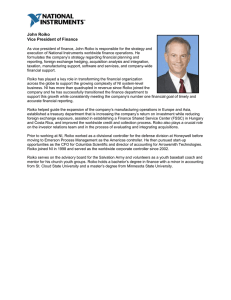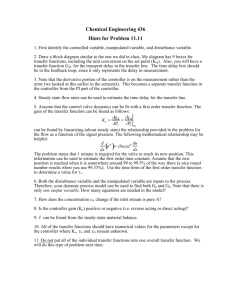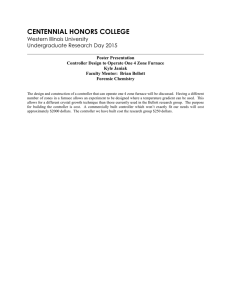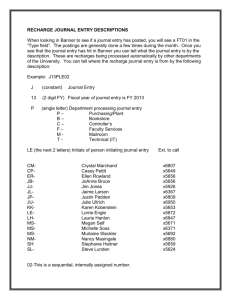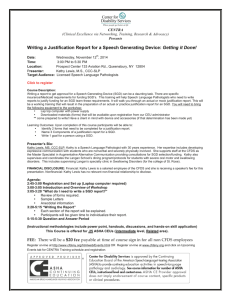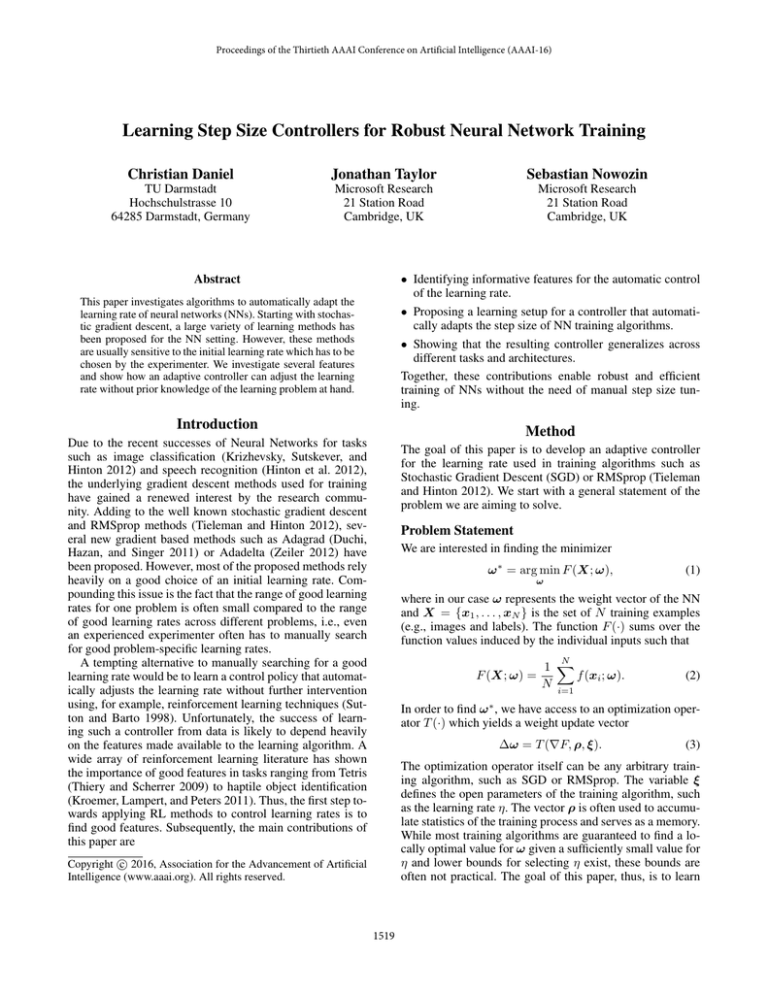
Proceedings of the Thirtieth AAAI Conference on Artificial Intelligence (AAAI-16)
Learning Step Size Controllers for Robust Neural Network Training
Christian Daniel
Jonathan Taylor
Sebastian Nowozin
TU Darmstadt
Hochschulstrasse 10
64285 Darmstadt, Germany
Microsoft Research
21 Station Road
Cambridge, UK
Microsoft Research
21 Station Road
Cambridge, UK
• Identifying informative features for the automatic control
of the learning rate.
• Proposing a learning setup for a controller that automatically adapts the step size of NN training algorithms.
• Showing that the resulting controller generalizes across
different tasks and architectures.
Together, these contributions enable robust and efficient
training of NNs without the need of manual step size tuning.
Abstract
This paper investigates algorithms to automatically adapt the
learning rate of neural networks (NNs). Starting with stochastic gradient descent, a large variety of learning methods has
been proposed for the NN setting. However, these methods
are usually sensitive to the initial learning rate which has to be
chosen by the experimenter. We investigate several features
and show how an adaptive controller can adjust the learning
rate without prior knowledge of the learning problem at hand.
Introduction
Method
Due to the recent successes of Neural Networks for tasks
such as image classification (Krizhevsky, Sutskever, and
Hinton 2012) and speech recognition (Hinton et al. 2012),
the underlying gradient descent methods used for training
have gained a renewed interest by the research community. Adding to the well known stochastic gradient descent
and RMSprop methods (Tieleman and Hinton 2012), several new gradient based methods such as Adagrad (Duchi,
Hazan, and Singer 2011) or Adadelta (Zeiler 2012) have
been proposed. However, most of the proposed methods rely
heavily on a good choice of an initial learning rate. Compounding this issue is the fact that the range of good learning
rates for one problem is often small compared to the range
of good learning rates across different problems, i.e., even
an experienced experimenter often has to manually search
for good problem-specific learning rates.
A tempting alternative to manually searching for a good
learning rate would be to learn a control policy that automatically adjusts the learning rate without further intervention
using, for example, reinforcement learning techniques (Sutton and Barto 1998). Unfortunately, the success of learning such a controller from data is likely to depend heavily
on the features made available to the learning algorithm. A
wide array of reinforcement learning literature has shown
the importance of good features in tasks ranging from Tetris
(Thiery and Scherrer 2009) to haptile object identification
(Kroemer, Lampert, and Peters 2011). Thus, the first step towards applying RL methods to control learning rates is to
find good features. Subsequently, the main contributions of
this paper are
The goal of this paper is to develop an adaptive controller
for the learning rate used in training algorithms such as
Stochastic Gradient Descent (SGD) or RMSprop (Tieleman
and Hinton 2012). We start with a general statement of the
problem we are aiming to solve.
Problem Statement
We are interested in finding the minimizer
ω ∗ = arg min F (X; ω),
ω
(1)
where in our case ω represents the weight vector of the NN
and X = {x1 , . . . , xN } is the set of N training examples
(e.g., images and labels). The function F (·) sums over the
function values induced by the individual inputs such that
F (X; ω) =
N
1 f (xi ; ω).
N i=1
(2)
In order to find ω ∗ , we have access to an optimization operator T (·) which yields a weight update vector
Δω = T (∇F, ρ, ξ).
(3)
The optimization operator itself can be any arbitrary training algorithm, such as SGD or RMSprop. The variable ξ
defines the open parameters of the training algorithm, such
as the learning rate η. The vector ρ is often used to accumulate statistics of the training process and serves as a memory.
While most training algorithms are guaranteed to find a locally optimal value for ω given a sufficiently small value for
η and lower bounds for selecting η exist, these bounds are
often not practical. The goal of this paper, thus, is to learn
c 2016, Association for the Advancement of Artificial
Copyright Intelligence (www.aaai.org). All rights reserved.
1519
Method
T (∇F, ρ, ξ)
ρ1
ρ2
SGD
−η∇F
—
—
Momentum
−ηρ1
ξ1 ρ1 +∇F
(∇F )2
—
Ê[(∇F )2 ]
—
Adagrad1
RMSprop2
3
Adam
Adadelta4
√
−η∇F/ ρ1
√
−η∇F/ ρ1
√
−ηρ2 / ρ1
−η∇F ρ2 /ρ1
2
features. Furthermore, we can use the individual gradients to
approximate the change in the actual function values. To this
effect, we approximate the functions using first order Taylor
expansions
—
Ê[(∇F ) ]
Ê[∇F ]
Ê(∇F )2 ]
Ê[(Δω)2 ]
f˜(xi ; ω + Δω) = f (xi ; ω) + ∇fiT Δω.
As stated by Equation (3), the update Δω only depends on
the average gradient and not the individual gradient. Thus,
Equation (6) yields the approximate function values fi (·)
after following the average gradient ∇F . For the simplest
optimization operator – SGD without momentum – this update evaluates to Δω = η∇F . However, most training algorithms do not only rely on the current gradient, but also on
accumulated statistics of previous gradient information. The
predictive function values take include the resulting effects
and, thus, will be more informative than taking only the individual gradients into account. Based on the predictive function values we are now ready to introduce the features which
will allow us to learn an adaptive step size controller.
Table 1: The most commonly used training methods. The
operator Ê computes the weighted expectation based on discount factors encoded in ξ. The step size η is also encoded
in ξ. Our controller is compatible with any of the described
methods. 1 (Duchi, Hazan, and Singer 2011), 2 (Tieleman and
Hinton 2012), 3 (Kingma and Ba 2014), 4 (Zeiler 2012)
a policy π(ξ|φ) which can adapt the open parameters of the
optimization operator T (·) based on features φ. The optimal
policy
p(φ)π(ξ|φ)r(ξ, φ) dφ dξ, (4)
π ∗ (ξ|φ) = arg max
Predictive change in function value. The first feature
we will consider is based on the predicted change in function values Δf˜i = f˜i − fi , where we abbreviated f˜i =
f˜(xi ; ω + Δω) . We will be interested in the variance of
the improvement of function values, i.e.,
(7)
φ1 = log Var(Δf˜i ) .
π
maximizes the average reward r(ξ, φ), where p(φ) is the
distribution over features.
The Features
The ability to learn effective policies hinges on the quality
of the features available. We are interested in finding features that are informative about the current state of the network while generalizing across different tasks and architectures. At the same time, we are constrained by the limits
on computational complexity commonly placed upon algorithms used for training NNs. Due to the high dimensionality
of the weight space, NNs are most often trained using first
order methods such as SGD. Thus, the computational complexity of generating informative features should not exceed
the complexity of the training algorithm. Furthermore, the
high dimensionality of the weight space also constrains the
memory requirements of the training algorithms. The size
of large scale NNs used today is often constrained by the
amount of physical memory available. Hence, the proposed
features will also need to be conservative in their memory
requirements.
Similarly to the function value itself, the overall gradient ∇F is composed of the individual gradient values, i.e.,
N
∇F = 1/N i=1 ∇fi , where
∇fi =
∂f (xi ; ω)
.
∂ω
(6)
This variance will not only tell us how much the gradients
disagree but, more importantly, how much the individual
function values are expected to change, based on all effects
of the chosen training algorithm.
Disagreement of function values. The variance of predicted changes in function values Var(Δf˜i ) can be related
to the variance of the current function values Var(fi ), i.e.,
φ2 = log Var (f (xi ; ω))
(8)
In general we expect that in the early stages of learning the
variance of function values will be high and, thus, the change
in function values will be equally large. As the training of
the NN progresses, the individual function values will be
funnelled to become more similar.
Mini Batch Setting
(5)
The features described above work well in the case of batch
training. However, large scale systems are most often trained
using mini batches. Mini batch training works by breaking up the training set X into subsets X̃ b ⊂ X, such that
∪B
b=1 X̃ b = X. While mini batch training increases the efficiency, it also introduces additional noise in the training
process. To counter this additional noise, we propose two
measures.
While we expect that following the negative average gradient −∇F will improve the overall function value F (·), it
will usually not improve all individual function values fi (·)
by the same amount. Indeed, we can easily imagine cases
where individual components will actually deteriorate by
following the average gradient. Thus, evaluating the agreement of the individual gradients is likely to yield informative
1520
Discounted Average. For every feature, we keep a running average of the observed feature value, i.e.,
φ̂i ← γ φ̂i + (1 − γ)φi ,
At the same time training of NNs exhibits many long-term
effects, such that changes in the step size may have large effects later on. Thus, we propose to learn the parameters θ
of a controller ξ = g(φ; θ), such that the described effects
are abstracted and the policy π(θ) will only have to decide
on a parametrization of the controller in the beginning of a
training run.
To this effect, we aim to find a distribution π(θ), such that
the resulting controllers are optimal, i.e,
π ∗ (θ) = arg max p(φ)π(θ)r(g(φ; θ), φ) dφ dθ. (11)
(9)
with a discount factor γ < 1. Relying on averaged feature values is beneficial in two ways. First, the averaging
smoothes over outliers in the feature values, which might
otherwise lead to a destabilization of the system due to an
overly large reaction of the controller. Furthermore, the averaged feature serves as a form of memory, similar to the
momentum term in SGD with momentum. Thus, features
observed in the current mini batch will influence the learning process for multiple iterations.
π
In particular, due to the continuous nature of the parameter space, we choose a RL method from the robot learning literature. Relative Entropy Policy Search (REPS) (Peters, Mülling, and Altun 2010) has been shown to work well
on high dimensional control tasks of real robots (Daniel et
al. 2013) and works well in combination with parametrized
controllers. The main insight used in REPS is that consecutive policy updates should remain ‘close’ to each other.
Constraining these updates is realized through a bound on
the Kullback-Leibler (KL) divergence of subsequent policies, i.e.,
DKL (π(θ)||q(θ)) ≤ ,
(12)
where q(θ) is the previous policy and is the user-defined
bound on the KL. The update rule for the policy π(θ) can be
obtained by first forming the Lagrangian and then its dual
formulation of the optimization problem defined by REPS.
The update is given as
Uncertainty Estimate. While averaging feature values
over optimization steps is beneficial due to a reduction of
noise, it is often desirable to have an explicit estimate of the
noise in the system. Intuitively, we would expect larger step
sizes to lead to an ever more unstable, and thus noisy, system. We estimate this noise level for every feature by calculating the variance of the centred feature values. To this
effect, we deduct our estimate of the mean feature value φ̂i
from the observed feature value φi , i.e.,
φ̂K+i ← γ φ̂K+i + (1 − γ)(φi − φ̂i )2 ,
(10)
where K is the number of ‘base’ features.
Computational Complexity & Memory Requirements.
As stated above, computational and memory requirements
are often hard constraints for large scale learning systems.
The proposed features are, thus, designed to have a minimal footprint and their memory requirements are constant
in the size of the network. In the naive implementation, the
memory requirements for computing the predictive function
values f˜i are linear in the number of inputs N . However, efficient implementations of the back-prop algorithm usually
compute all gradients ∇fi for one layer in the network first,
before computing the gradients for the next layer. Thus, we
can simply compute the partial predictive change in function value on a per-layer basis and do not need to store all
individual gradients for all layers. Computing the feature requires only a matrix vector multiplication, which introduces
minimal overhead.
π(θ) ∝ q(θ) exp(r(θ)/η),
(13)
where η is found through the optimization of the dual representation. Given an initial distribution, REPS will iteratively
restrict the search space and converge to a locally optimal
solution for π(θ).
Related Work
The NN community has proposed multiple training methods based on statistics similar in spirit to the features we
propose. In Table 1, we give an overview of the most commonly used methods. One of the first method to make
use of additional statistics was SGD with momentum (Jacobs 1988), which keeps a discounted history of past gradients. RMSprop (Tieleman and Hinton 2012) is inspired
by RPROP (Riedmiller and Braun 1993), which adapts a
learning rate per weight based on the observed sign changes
in the gradients. RMSprop uses a discounted history of the
squared gradients as a form of preconditioner. It has been argued that this form of preconditioning approximates the diagonal of the Hessian if the changes Δω are close to being
Gaussian distributed (Dauphin et al. 2015). Adagrad (Duchi,
Hazan, and Singer 2011) replaces the discounted history
over squared gradients with the sum over squared gradients. Using the sum instead of the gradient can be problematic since it may decrease the effective step sizes too
fast if the gradients remain large over multiple iterations.
Adam (Kingma and Ba 2014) follows RMSprop in discounting the preconditioner and additionally averages over
Learning a Controller
Given access to a set of informative features, we now describe the proposed setting to learn a policy which maximizes the average reward as given in Equation (4). The
most general solution to the problem stated above is to solve
the delayed reward problem using infinite horizon RL techniques. Unfortunately, this approach poses two problems in
the proposed setting. First, the system we are aiming to control will be very noisy, mostly due to the mini batch setting.
Second, the problem we are aiming to solve is not Markovian in nature. This means that we cannot hope to have access to features which fully describe the state of the system.
1521
MNIST Controlled RMSprop Sensitivity to η 0
Full Training Error
MNIST RMSprop
100
10−2
100
100
Ours
RMS η = 5e-05
RMS η = 1e-04
RMS η = 5e-04
RMS η = 1e-03
RMS η = 5e-03
101
10−2
102
103
(a) Sensitivity analysis of static step sizes on MNIST.
100
Full Training Error
10−1 0
10
100
10−1 0
10
102
103
Optimization Steps
(c) Sensitivity analysis of static step sizes on CIFAR.
102
103
CIFAR Controlled RMSprop Sensitivity to η 0
Ours
RMS η = 5e-05
RMS η = 1e-04
RMS η = 5e-04
RMS η = 1e-03
RMS η = 5e-03
101
101
(b) Sensitivity analysis of the proposed approach on MNIST.
CIFAR RMSprop
100
Ours η 0 = 5e-05
Ours η 0 = 1e-04
Ours η 0 = 5e-04
Ours η 0 = 5e-03
Ours η 0 = 1e-03
RMS best η
Ours η 0 = 5e-05
Ours η 0 = 1e-04
Ours η 0 = 5e-04
Ours η 0 = 1e-03
Ours η 0 = 5e-03
RMS best η
101
102
103
Optimization Steps
(d) Sensitivity analysis of the proposed approach on CIFAR.
Figure 1: Evaluation of the proposed approach in combination with the RMSprop training algorithm. (a) The RMSprop algorithm is sensitive to the choice of the step size. The proposed approach of controlling step size outperforms the best static
step size. (b) The proposed approach is not sensitive to the choice of initial step size. Asympotic performance of the proposed
approach is better than the best static step size in all cases. In early iterations a poor choice of η0 decreases performace while
the controller is adapting the step size. (c,d) The results on the CIFAR data set confirm the results of the experiments on the
MNIST data set.
the discounted average of the gradients ∇F . The discounting scheme in Adam is more complex than in the other
methods as the discount factor itself is decayed over time.
Adadelta (Zeiler 2012) also follows RMSprop in the use of
the preconditioner but introduces an additional statistic, i.e.,
the expected squared change of weights Ê[Δω 2 ]. This statistic rescales the effective step size proportionally to the history of effective step sizes.
eters. Schaul et al. (Schaul, Zhang, and LeCun 2013) showed
how for the SGD method good learning rates can be chosen under the assumption that the optimal weights ω i for
the instances xi are normal distributed and access to the
second order derivative is available. Using these assumptions they show how learning rates can be set either globally
or on a per-weight basis. While our proposed approach is
based on global learning rates, we are not restricted to specific methods. TONGA (Le Roux, Bengio, and Fitzgibbon
2012) models the uncertainty in the weight update by building a model of the gradients. This approach is closely related to the idea of the natural gradient (Amari 1998), which
has also been applied to neural networks (Bastian, Gunther,
and Moon 2011). However, these methods are expensive in
terms of computational requirements. Finally, the proposed
method is compatible with distributed approaches (Zhang,
Duchi, and Wainwright 2012).
Since setting a static learning rate for a whole training run is often insufficient, popular approaches usually
start by finding a good initial learning rate either manually,
or, for example, through Bayesian Optimization (Snoek,
Larochelle, and Adams 2012). Subsequently, the learning rate is decreased following a predefined scheme (Senior et al. 2013). Possible schemes include the ‘waterfall’
scheme (Senior et al. 2013), which keeps η constant for multiple steps and then reduces it by large amounts, as well as
the exponential scheme (Sutton 1992) and power scheduling (Darken and Moody 1990). However, all of these methods require the practitioner to define additional open param-
1522
MNIST Controlled SGD Sensitivity to η 0
Full Training Error
MNIST SGD
100
10−1
10−2
10−3 0
10
100
Ours
SGD η = 5e-05
SGD η = 1e-04
SGD η = 5e-04
SGD η = 1e-03
SGD η = 5e-03
SGD η = 1e-02
101
10−1
10−2
102
10−3 0
10
103
(a) Sensitivity analysis of static step sizes on MNIST.
Full Training Error
10−3 0
10
100
Ours
SGD η = 5e-05
SGD η = 1e-04
SGD η = 5e-04
SGD η = 1e-03
SGD η = 5e-03
SGD η = 1e-02
101
102
103
Optimization Steps
102
103
CIFAR Controlled SGD Sensitivity to η 0
100
10−2
101
(b) Sensitivity analysis of the proposed approach on MNIST.
CIFAR SGD
10−1
Ours η 0 = 5e-05
Ours η 0 = 1e-04
Ours η 0 = 5e-04
Ours η 0 = 1e-03
Ours η 0 = 5e-03
Ours η 0 = 1e-02
SGD best η
10−1
10−2
10−3 0
10
104
(c) Sensitivity analysis of static step sizes on CIFAR.
Ours η 0 = 5e-05
Ours η 0 = 1e-04
Ours η 0 = 5e-04
Ours η 0 = 1e-03
Ours η 0 = 5e-03
Ours η 0 = 1e-02
SGD best η
101
102
103
Optimization Steps
104
(d) Sensitivity analysis of the proposed approach on CIFAR.
Figure 2: Evaluation of the proposed approach in combination with the SGD training algorithm with momentum. (a,b) The
results show that while choosing a static step size has a large influence on the training performance, the learned controller has
very similar asymptotic performance for all choices of η0 . (c,d) The results on the CIFAR data set confirm the results of the
MNIST experiment. The proposed approach in not sensitive to the choice of η0 and outperforms the static step size.
Experiments
were training on between 0.1 and 0.5 of the full MNIST data
set, where we always sampled from only one half of the full
data set, such that during training the algorithms never saw
the second half. We trained the controller exclusively on this
smaller network and the MNIST-Small data set. Finally, we
randomly sampled the number of optimization steps the NN
was trained for between 300 steps and 1000 steps.
In this work we considered two widely used training algorithms: SGD with momentum and RMSprop and set the
remaining open parameters to the values recommended in
the respective literature. For SGD, the momentum was set
to 0.9. For RMSprop, the discount factor was set to 0.9 and
= 10−6 . The setup was robust to restarts with different random seeds. For example, Fig. 1d shows that even with different initial values for η0 , the performance of the proposed
approach was close to identical. Thus, for the presented experiments, we only performed a single run per setting.
We evaluated the proposed features and the learning approach on two settings, the MNIST hand written digit classification task and the CIFAR-10 image classification task.
Furthermore, we evaluated the proposed features across two
learning algorithms, SGD and RMSprop. We aim to show
that both the features and the controller generalize across
problems. Thus, instead of learning the best possible controller for a given setup, we learned the parameters of the
controller on small convolutional networks using only a subset of the MNIST data set. We called this smaller data set
MNIST-Small, which contained half the MNIST data set.
The Training Network. To learn a controller that generalizes, we randomly sampled networks and data sets during
learning. Specifically, we fixed the architecture to a convolutional neural network of the structure c-p-c-p-c-r-c-s, where
{c, p, r, s} represented convolutional, pooling, rectified linear and softmax layers, respectively. Within this structure
we randomly sampled the number of convolutional filters
between [2 5 50] and [10 25 250] per layer. Similarly, we
randomly sampled the ratio of the MNIST-Small data set we
The Controller. To learn the controller, we initialized the
policy π(θ) to a Gaussian with isotropic covariance. In each
iteration of learning, we randomly sampled a parameter vector from π(θ) as well as a network and a training set. Each
1523
chosen static step sizes. The learned controller balanced
the variance in predicted change in function value with the
variance of observed function values. The controller also
learned to decrease the step size proportionally to the uncertainty estimate in Equation (10). The learned parameters
are given as θ = [1.62, −0.35, 0.3, −0.33, −0.03]T ∗ 10−2 ,
with φ = [1, φ1 , . . . , φ4 ]T . The results in Fig. 1a show that
the best static step size seemed to be η = 10−4 and that the
static method was sensitive to this choice. Furthermore, the
results show that the proposed controller outperformed the
best static step size.
After observing that RMSprop is sensitive to the choice of
η, we evaluated the sensitivity of the controlled RMSprop to
the best choice of a static step size. The results in Fig. 1b
show that the proposed method was less sensitive to the
choice of initial step size. The results also show that the proposed method had better asymptotic performance than the
best static step size in all settings.
We repeated the same evaluation with the same controller
on the CIFAR data set. The results show an advantage for the
proposed method similar to the results reported above. The
results in Fig. 1c show that the static method was sensitive
to the choice of a step size, while the results in Fig. 1d show
that the proposed method was robust to the choice of initial
step size.
To evaluate the robustness of the learned controller to its
parameter values, we varied all parameters within 20% of
the parameters, i.e., we tried all parameters in a 3x3x3 cube
around the learned values. The results in Fig. 4 show that the
controller is robust to these small changes in the parameters.
Finally, in Fig. 3 we evaluated the validation error, taking
into account the computational overhead of our method. The
results show that while the total runtime for our method is
longer, it yields the best validation error in most time steps.
Validation Error vs. Wall Clock
Validation Error
10
1
Ours
SGD η = 5e-05
SGD η = 1e-04
SGD η = 5e-04
SGD η = 1e-03
SGD η = 5e-03
100
10−1
100
200
300
400
Wall Clock Time [s]
500
Figure 3: Evaluation of the validation error, adjusted for the
computational overhead. Results show the RMSprop training method on the MNIST data set.
iteration of learning was based on 20 samples. The open parameter in REPS was set to = 1. The parametrized controller was given as g(φ̂; θ) = exp(θ T φ̂). The reward function used for learning the controller was given as
1 log(Es ) − log(Es−1 ) ,
S − 1 s=2
S
r=−
(14)
where S was the total number of optimization steps for a
given run. For all experiments we set the discount factor in
Equation (10) to γ = 0.9. Changing this value did not have a
large effect in our experiments within a range of [0.5, 0.99].
Results. We evaluated the proposed methods, controlled
SGD-Momentum and controlled RMSprop, on the MNIST
and CIFAR data sets. The results show that the proposed
controller generalized over different data sets and network
architectures. As could be expected, the same controller parameters did, however, not generalize over different training
methods. The respective architectures were given as c-p-cp-c-r-c-s, with [20 50 500] filters per convolutional layer for
MNIST and c-p-r-c-r-p-c-r-p-c-r-c-s with [32, 32, 64, 64] for
CIFAR. We based our implementation on the MatConvNet
toolbox (Vedaldi and Lenc 2014). We evaluated the methods up to the point where the validation error increased.
Evaluating the proposed method for even more steps would
have lead to bigger advantages for our methods, however,
at that point the networks were usually over-fitting to the
training data. In our experiments, we observed a computational overhead of 36%, mostly due to the computation of
f˜(xi ; ω + Δω) in Eq. (6). However, our implementation
was not fully optimized and could be improved. This overhead did not include the initial training time of the RL algorithm, which took about six hours. However, as the experiments show, this initial training has to be performed only
once and the resulting controller can be re-used for different
problems.
Controlled SGD-Momentum. The controllers learned for
RMSprop largely followed our intuition in that they balanced the predictive change in function value in Equation (7)
with the variance of observed function values in Equation (8). Furthermore, the learned controllers decreased η
proportionally to the noise levels estimated by the uncertainty estimates in Equation (10). Thus, we could reduce
the search space for the SGD experiments by combining the
respective features. In particular, the feature vector became
φ = [1, φ̂1 − φ̂2 , φ̂3 + φ̂4 ]T and the learned parameters were
θ = [−4.55 − 2.87 − 2.52] ∗ 10−2 . The results in Figures 2a
to 2d are similar to the results reported for RMSprop. In all
experiments the static step size approach seems to be sensitive to the choice of η, while the proposed approach outperforms the best static step size and is less sensitive to the
initial choice of η0 .
Discussion & Conclusion
We presented a set of features suitable to learn a controller
for the step size of NN training algorithms. The results show
that the learned controller generalized to larger networks
and the full MNIST data set, as well as to a different architecture and the CIFAR data set. The learned controller
Controlled RMSprop. We started by evaluating the controlled RMSprop training method to a range of manually
1524
Krizhevsky, A.; Sutskever, I.; and Hinton, G. E. 2012. ImageNet Classification with Deep Convolutional Neural Networks. Advances In Neural Information Processing Systems
(NIPS).
Kroemer, O.; Lampert, C.; and Peters, J. 2011. Learning
Dynamic Tactile Sensing with Robust Vision-based Training. IEEE Transactions on Robotics (T-Ro) (3):545–557.
Le Roux, N.; Bengio, Y.; and Fitzgibbon, A. 2012. Improving First and Second-Order Methods by Modeling Uncertainty. Optimization for Machine Learning 403.
Peters, J.; Mülling, K.; and Altun, Y. 2010. Relative Entropy
Policy Search. In Proceedings of the National Conference
on Artificial Intelligence (AAAI).
Riedmiller, M., and Braun, H. 1993. A direct adaptive
method for faster backpropagation learning: The RPROP algorithm. Neural Networks.
Schaul, T.; Zhang, S.; and LeCun, Y. 2013. No More
Pesky Learning Rates. International Conference on Machine Learning (ICML).
Senior, A.; Heigold, G.; Ranzato, M.; and Yang, K. 2013. An
empirical study of learning rates in deep neural networks for
speech recognition. In 2013 IEEE International Conference
on Acoustics, Speech and Signal Processing (ICASSP).
Snoek, J.; Larochelle, H.; and Adams, R. P. 2012. Practical
bayesian optimization of machine learning algorithms. In
Advances in Neural Information Processing Systems (NIPS).
Sutton, R., and Barto, A. 1998. Reinforcement learning: An
introduction. MIT press Cambridge.
Sutton, R. 1992. Adapting bias by gradient descent: An
incremental version of delta-bar-delta. Proceedings of the
National Conference on Artificial Intelligence (AAAI).
Thiery, C., and Scherrer, B. 2009. Building controllers for
Tetris. International Computer Games Association Journal.
Tieleman, T., and Hinton, G. 2012. Lecture 6.5 RMSprop:
Divide the Gradient by The Running Average of its recent
magnitude. In COURSERA: Neural Networks for Machine
Learning.
Vedaldi, A., and Lenc, K. 2014. MatConvNet – Convolutional Neural Networks for MATLAB. CoRR abs/1412.4.
Zeiler, M. D. 2012. ADADELTA: An adaptive learning rate
method. arXiv preprint arXiv:1212.5701.
Zhang, Y.; Duchi, J. C.; and Wainwright, M. J. 2012.
Communication-efficient algorithms for statistical optimization. In Advances in Neural Information Processing Systems
(NIPS).
Full Training Error
Perturbations of Controller Parameters
100
10−1
10−2
10−3 0
10
Variations of parameter vector θ
Mean θ
101
102
Optimization Steps
103
Figure 4: Evaluation of the robustness of the controller parameters on the MNIST data set.
is also robust to initial values of the learning rate. However, the learned controller does not generalize over different training algorithms. Using the presented methodology,
it is straight-forward to generalize commonly used methods
by treating their specific accumulated statistics as features.
Given enough computational resources, future work should
investigate learning a controller on this accumulated feature
set and possibly combine the best of all worlds.
References
Amari, S. 1998. Natural gradient works efficiently in learning. Neural computation.
Bastian, M.; Gunther, J.; and Moon, T. 2011. A simplified
natural gradient learning algorithm. Advances in Artificial
Neural Systems.
Daniel, C.; Neumann, G.; Kroemer, O.; and Peters, J. 2013.
Learning sequential motor tasks. In Proceedings of the
IEEE International Conference on Robotics and Automation
(ICRA).
Darken, C., and Moody, J. 1990. Fast adaptive k-means
clustering: some empirical results. International Joint Conference on Neural Networks (IJCNN).
Dauphin, Y. N.; de Vries, H.; Chung, J.; and Bengio, Y.
2015. RMSProp and equilibrated adaptive learning rates for
non-convex optimization. arXiv preprint arXiv:1502.04390.
Duchi, J.; Hazan, E.; and Singer, Y. 2011. Adaptive subgradient methods for online learning and stochastic optimization. The Journal of Machine Learning Research (JMLR)
12:2121–2159.
Hinton, G.; Deng, L.; Yu, D.; Dahl, G. E.; Mohamed, A.-r.;
Jaitly, N.; Senior, A.; Vanhoucke, V.; Nguyen, P.; Sainath,
T. N.; and Others. 2012. Deep neural networks for acoustic
modeling in speech recognition: The shared views of four research groups. IEEE Signal Processing Magazine 29(6):82–
97.
Jacobs, R. 1988. Increased rates of convergence through
learning rate adaptation. Neural networks.
Kingma, D., and Ba, J. 2014. Adam: A method for stochastic
optimization. arXiv preprint arXiv:1412.6980.
1525

